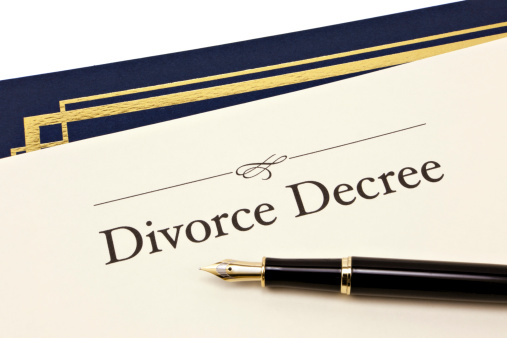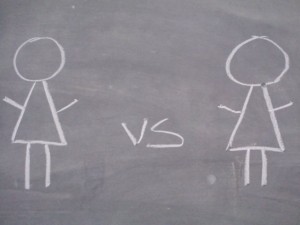 The second definition provides a visual for what many think a divorce “looks like.” While the end of a marriage is emotionally tumultuous and devastating, the actual legal process of uncoupling does not have to be. But, it is critical that you choose a process that promotes healing. The Collaborative Process does just that.
Collaboration is a holistic approach to divorce. It can be utilized by couples who are ending either a marriage or significant relationship, or who have a child or children together. Although some people question whether it is an appropriate process when domestic abuse or mental health/chemical dependency issues are present, many others think it can (and should) at least be attempted. If you don’t want to be another “divorce horror story,” the Collaborative Process will likely be a great fit.
Collaboration focuses on the future (i.e., the relationship of co-parenting in two homes) rather than the past (i.e. the vilification of one spouse); is a win-win for both partners (rather than a court-imposed win-lose); and emphasizes the well-being of the entire family. You don’t air your dirty laundry in court, and you aren’t (literally) judged. In fact, you never set foot in a courtroom. The negotiation model is interest-based/win-win, rather than positional/win-lose. You pay attorneys to help you solve problems, not argue and keep you stuck in the past. Every family is unique, so every family deserves a unique solution. And if you have young children, please keep in mind they need you present and available. You can’t be present when you are fighting the other parent in court. In Part 3, we will discuss the various professionals in the Collaborative Process and how their expertise can help you avoid the divortex.
The second definition provides a visual for what many think a divorce “looks like.” While the end of a marriage is emotionally tumultuous and devastating, the actual legal process of uncoupling does not have to be. But, it is critical that you choose a process that promotes healing. The Collaborative Process does just that.
Collaboration is a holistic approach to divorce. It can be utilized by couples who are ending either a marriage or significant relationship, or who have a child or children together. Although some people question whether it is an appropriate process when domestic abuse or mental health/chemical dependency issues are present, many others think it can (and should) at least be attempted. If you don’t want to be another “divorce horror story,” the Collaborative Process will likely be a great fit.
Collaboration focuses on the future (i.e., the relationship of co-parenting in two homes) rather than the past (i.e. the vilification of one spouse); is a win-win for both partners (rather than a court-imposed win-lose); and emphasizes the well-being of the entire family. You don’t air your dirty laundry in court, and you aren’t (literally) judged. In fact, you never set foot in a courtroom. The negotiation model is interest-based/win-win, rather than positional/win-lose. You pay attorneys to help you solve problems, not argue and keep you stuck in the past. Every family is unique, so every family deserves a unique solution. And if you have young children, please keep in mind they need you present and available. You can’t be present when you are fighting the other parent in court. In Part 3, we will discuss the various professionals in the Collaborative Process and how their expertise can help you avoid the divortex.
In Part 1, vortex was defined as:
1) a whirling mass of water or air that sucks everything near it towards its center;
2) a place or situation regarded as drawing into its center all that it surrounds, and hence, being inescapable or destructible. The second definition provides a visual for what many think a divorce “looks like.” While the end of a marriage is emotionally tumultuous and devastating, the actual legal process of uncoupling does not have to be. But, it is critical that you choose a process that promotes healing. The Collaborative Process does just that.
Collaboration is a holistic approach to divorce. It can be utilized by couples who are ending either a marriage or significant relationship, or who have a child or children together. Although some people question whether it is an appropriate process when domestic abuse or mental health/chemical dependency issues are present, many others think it can (and should) at least be attempted. If you don’t want to be another “divorce horror story,” the Collaborative Process will likely be a great fit.
Collaboration focuses on the future (i.e., the relationship of co-parenting in two homes) rather than the past (i.e. the vilification of one spouse); is a win-win for both partners (rather than a court-imposed win-lose); and emphasizes the well-being of the entire family. You don’t air your dirty laundry in court, and you aren’t (literally) judged. In fact, you never set foot in a courtroom. The negotiation model is interest-based/win-win, rather than positional/win-lose. You pay attorneys to help you solve problems, not argue and keep you stuck in the past. Every family is unique, so every family deserves a unique solution. And if you have young children, please keep in mind they need you present and available. You can’t be present when you are fighting the other parent in court. In Part 3, we will discuss the various professionals in the Collaborative Process and how their expertise can help you avoid the divortex.
The second definition provides a visual for what many think a divorce “looks like.” While the end of a marriage is emotionally tumultuous and devastating, the actual legal process of uncoupling does not have to be. But, it is critical that you choose a process that promotes healing. The Collaborative Process does just that.
Collaboration is a holistic approach to divorce. It can be utilized by couples who are ending either a marriage or significant relationship, or who have a child or children together. Although some people question whether it is an appropriate process when domestic abuse or mental health/chemical dependency issues are present, many others think it can (and should) at least be attempted. If you don’t want to be another “divorce horror story,” the Collaborative Process will likely be a great fit.
Collaboration focuses on the future (i.e., the relationship of co-parenting in two homes) rather than the past (i.e. the vilification of one spouse); is a win-win for both partners (rather than a court-imposed win-lose); and emphasizes the well-being of the entire family. You don’t air your dirty laundry in court, and you aren’t (literally) judged. In fact, you never set foot in a courtroom. The negotiation model is interest-based/win-win, rather than positional/win-lose. You pay attorneys to help you solve problems, not argue and keep you stuck in the past. Every family is unique, so every family deserves a unique solution. And if you have young children, please keep in mind they need you present and available. You can’t be present when you are fighting the other parent in court. In Part 3, we will discuss the various professionals in the Collaborative Process and how their expertise can help you avoid the divortex.
 The second definition provides a visual for what many think a divorce “looks like.” While the end of a marriage is emotionally tumultuous and devastating, the actual legal process of uncoupling does not have to be. But, it is critical that you choose a process that promotes healing. The Collaborative Process does just that.
Collaboration is a holistic approach to divorce. It can be utilized by couples who are ending either a marriage or significant relationship, or who have a child or children together. Although some people question whether it is an appropriate process when domestic abuse or mental health/chemical dependency issues are present, many others think it can (and should) at least be attempted. If you don’t want to be another “divorce horror story,” the Collaborative Process will likely be a great fit.
Collaboration focuses on the future (i.e., the relationship of co-parenting in two homes) rather than the past (i.e. the vilification of one spouse); is a win-win for both partners (rather than a court-imposed win-lose); and emphasizes the well-being of the entire family. You don’t air your dirty laundry in court, and you aren’t (literally) judged. In fact, you never set foot in a courtroom. The negotiation model is interest-based/win-win, rather than positional/win-lose. You pay attorneys to help you solve problems, not argue and keep you stuck in the past. Every family is unique, so every family deserves a unique solution. And if you have young children, please keep in mind they need you present and available. You can’t be present when you are fighting the other parent in court. In Part 3, we will discuss the various professionals in the Collaborative Process and how their expertise can help you avoid the divortex.
The second definition provides a visual for what many think a divorce “looks like.” While the end of a marriage is emotionally tumultuous and devastating, the actual legal process of uncoupling does not have to be. But, it is critical that you choose a process that promotes healing. The Collaborative Process does just that.
Collaboration is a holistic approach to divorce. It can be utilized by couples who are ending either a marriage or significant relationship, or who have a child or children together. Although some people question whether it is an appropriate process when domestic abuse or mental health/chemical dependency issues are present, many others think it can (and should) at least be attempted. If you don’t want to be another “divorce horror story,” the Collaborative Process will likely be a great fit.
Collaboration focuses on the future (i.e., the relationship of co-parenting in two homes) rather than the past (i.e. the vilification of one spouse); is a win-win for both partners (rather than a court-imposed win-lose); and emphasizes the well-being of the entire family. You don’t air your dirty laundry in court, and you aren’t (literally) judged. In fact, you never set foot in a courtroom. The negotiation model is interest-based/win-win, rather than positional/win-lose. You pay attorneys to help you solve problems, not argue and keep you stuck in the past. Every family is unique, so every family deserves a unique solution. And if you have young children, please keep in mind they need you present and available. You can’t be present when you are fighting the other parent in court. In Part 3, we will discuss the various professionals in the Collaborative Process and how their expertise can help you avoid the divortex. 


 Almost all divorces end up in a negotiated settlement. (In most states, less than 5% of all divorces actually go to trial.) Therefore, the most important thing for couples to consider, before they start down the path toward divorce, is how to negotiate the best possible resolution to your divorce.
When I ask most clients what they want from a divorce process, they almost always talk about two things:
1.) They want a divorce that is amicable.
This makes sense. Most wise people would want an amicable divorce; either for the sake of their children, the protection of their finances, preserving their own mental health, or all three. No sane person would choose to have a messy divorce if they can avoid it.
2.) They want to feel protected.
At the same time, almost everyone wants to feel some sense of protection. They are entering into important agreements that will impact their lives and, perhaps, the lives of the children for many years. They do not want to sign an agreement that they will resent or regret.
These two negotiating goals do not need to conflict with each other.
The biggest mistake that people can make is thinking that these two goals are in conflict with each other. They want an amicable divorce but they think the need to hire an aggressive lawyer to protect their needs. Or, alternatively, they think that all lawyers will be aggressive so they avoid getting legal counsel and end up with a settlement that they regret.
Contrary to common belief, it is possible for divorcing clients to have the “best of both worlds”. This is the very reason that
Almost all divorces end up in a negotiated settlement. (In most states, less than 5% of all divorces actually go to trial.) Therefore, the most important thing for couples to consider, before they start down the path toward divorce, is how to negotiate the best possible resolution to your divorce.
When I ask most clients what they want from a divorce process, they almost always talk about two things:
1.) They want a divorce that is amicable.
This makes sense. Most wise people would want an amicable divorce; either for the sake of their children, the protection of their finances, preserving their own mental health, or all three. No sane person would choose to have a messy divorce if they can avoid it.
2.) They want to feel protected.
At the same time, almost everyone wants to feel some sense of protection. They are entering into important agreements that will impact their lives and, perhaps, the lives of the children for many years. They do not want to sign an agreement that they will resent or regret.
These two negotiating goals do not need to conflict with each other.
The biggest mistake that people can make is thinking that these two goals are in conflict with each other. They want an amicable divorce but they think the need to hire an aggressive lawyer to protect their needs. Or, alternatively, they think that all lawyers will be aggressive so they avoid getting legal counsel and end up with a settlement that they regret.
Contrary to common belief, it is possible for divorcing clients to have the “best of both worlds”. This is the very reason that 




 Wow, the phrase “First vs. Second Wives” makes me cringe. There is so much wrong with it, or at least so much to dislike or be uncomfortable about.
Let me count the ways (Keep in mind that this is in the context of Spousal Maintenance).
It implies that there will be another wife after the first, which is a fair assumption, but still. It implies that the first and second wives will be at odds with each other over money, which is unfortunate and sad to think about. It implies that the husband, at least in his first marriage, is the breadwinner.
In our culture of perceived independence and self-sufficiency, it may strike us as dependent and therefore inconsistent with current cultural standards.
It uncomfortably reminds us that many spouses, most likely the wife and often for good reasons, give up career and educational advancement, and so their future financial independence and self-sufficiency, to stay at home with children for the benefit of the greater family. Then, if they divorce, they are in big financial trouble without consistent and lengthy financial support from their ex.
I’ve seen many couples divorce where the breadwinner doesn’t want to or just won’t acknowledge the homemaker’s non-financial contribution to the family and opportunity cost of being out of the workforce or taking a lower-paying, more flexible job. I’ve also seen many cases where the homemaker never left home after the kids were older, when it would have been more appropriate to find employment, because re-entering the job market was likely the original marital intent.
There is an interesting article in Time magazine’s May 27, 2013 edition titled “The End of Alimony” and a short radio segment, along eerily similar lines, on NPR titled “
Wow, the phrase “First vs. Second Wives” makes me cringe. There is so much wrong with it, or at least so much to dislike or be uncomfortable about.
Let me count the ways (Keep in mind that this is in the context of Spousal Maintenance).
It implies that there will be another wife after the first, which is a fair assumption, but still. It implies that the first and second wives will be at odds with each other over money, which is unfortunate and sad to think about. It implies that the husband, at least in his first marriage, is the breadwinner.
In our culture of perceived independence and self-sufficiency, it may strike us as dependent and therefore inconsistent with current cultural standards.
It uncomfortably reminds us that many spouses, most likely the wife and often for good reasons, give up career and educational advancement, and so their future financial independence and self-sufficiency, to stay at home with children for the benefit of the greater family. Then, if they divorce, they are in big financial trouble without consistent and lengthy financial support from their ex.
I’ve seen many couples divorce where the breadwinner doesn’t want to or just won’t acknowledge the homemaker’s non-financial contribution to the family and opportunity cost of being out of the workforce or taking a lower-paying, more flexible job. I’ve also seen many cases where the homemaker never left home after the kids were older, when it would have been more appropriate to find employment, because re-entering the job market was likely the original marital intent.
There is an interesting article in Time magazine’s May 27, 2013 edition titled “The End of Alimony” and a short radio segment, along eerily similar lines, on NPR titled “